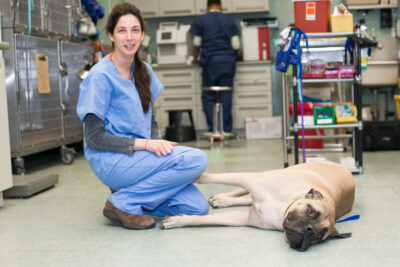Should I learn Cardiopulmonary Resuscitation (CPR) for pets?

Should I learn Cardiopulmonary Resuscitation (CPR) for pets?
Cardiopulmonary resuscitation (CPR) is an emergency first-aid technique that sustains blood flow to the brain and heart in the event of cardiac arrest. Many Good Samaritans will learn this technique as part of a first aid course in hopes of saving a life in the event of an emergency. But what about pets? Should we learn to perform CPR on our pets in case we need to save their life? What are the risks and benefits of performing CPR on pet?
Animal CPR is for Experts
CPR in pets has very different risks and considerations than CPR in humans, so animal CPR is best done by experts who have the skills, tools and monitoring equipment to have the best shot at resuscitation. AMC’s emergency critical care specialists are trained to perform CPR in a range of species and breeds, including dogs ranging in size from Chihuahua to Cane Corso. Even when CPR is performed in a level I trauma center like the Animal Medical Center – with its highly trained staff, well stocked pharmacy, intravenous catheters, breathing tubes and machines to support oxygen delivery – only about 10% of pets suffering a non-anesthesia related cardiac arrest are discharged from the hospital.
CPR Should Not Delay Transportation to the Veterinary Emergency Room
We enroll in a human CPR course so we can perform it until the ambulance crew and EMTs arrive. However, in the case of our pets, WE are the ambulance driver and the EMT. So, if performing CPR will delay transport to the nearest animal ER, you should not perform CPR and instead should go immediately to the nearest animal ER. If someone else is driving, then by all means, attempt CPR.
This advice is analogous to the results of a canine heatstroke study where cooling a dog before transporting it to the animal ER did not improve outcome. Dogs with a long lag time between developing heatstroke and arrival at the animal ER had a worse outcome. Getting to the ER fast is critical for achieving a positive outcome.
Pets Need CPR for Different Reasons than Humans
Heart attacks are the most common cause of an unexpected cardiac arrest in people. Rapid initiation of chest compressions will help maintain blood circulation while the ambulance comes. Pets do not have heart attacks and when they suffer a cardiac arrest, they do so because they have a serious systemic illness. CPR may not be enough to sustain life in a pet with an illness serious enough to incite a cardiac arrest.
CPR Risks to You
Performing CPR on a sick or frightened pet is a bite injury waiting to happen. Should your CPR efforts succeed in reviving your pet, pay extra attention to your pet’s reaction and be aware of the risk for bite injury. Since cardiac arrest in pets is usually the result of a serious systemic illness, performing CPR on your pet could also result in exposure to a contagious disease. When performing CPR, AMC’s emergency room staff has access to a variety of personal protective equipment to protect against a contagious disease.
Prepare for Pet Emergencies
Want to learn more about how you can prevent and prepare for emergencies with your pet family? Listen to our September episode of the “Ask the Vet” podcast with Dr. Ann Marie Zollo a board-certified emergency and critical care veterinarian in AMC’s Emergency and Critical Care Service.































